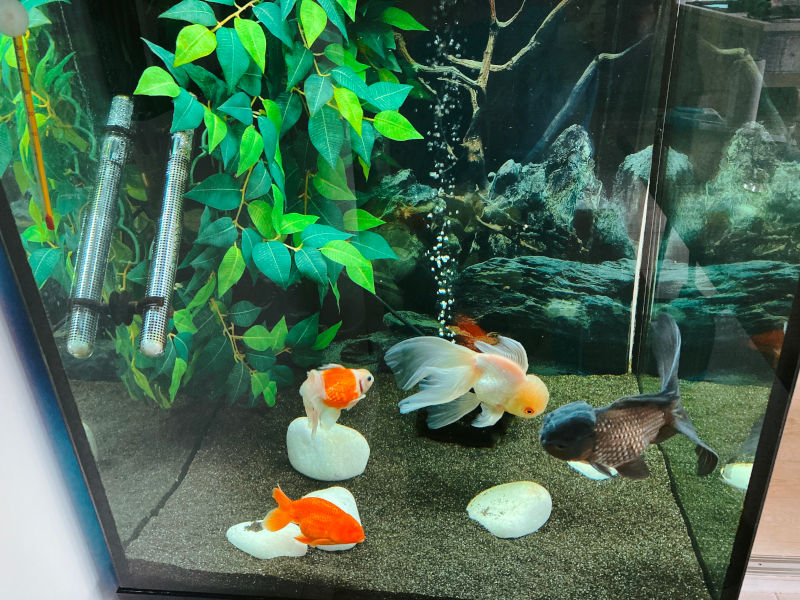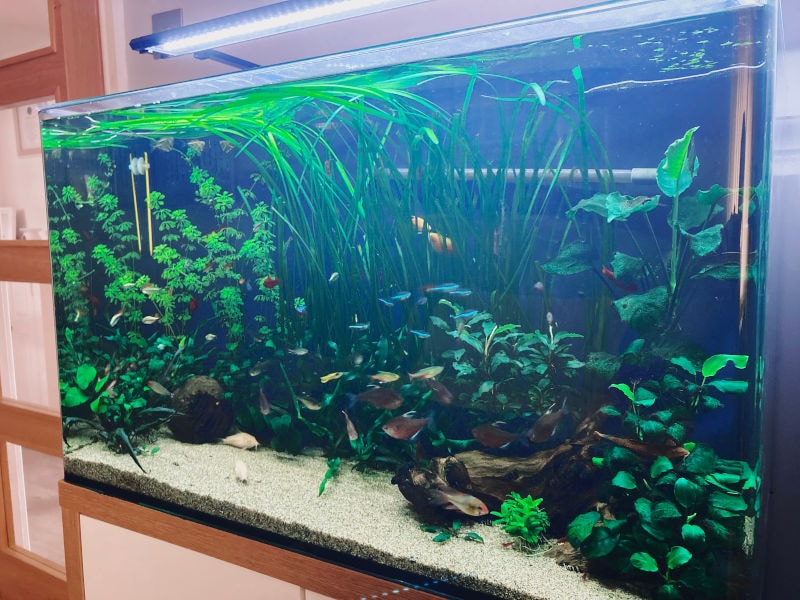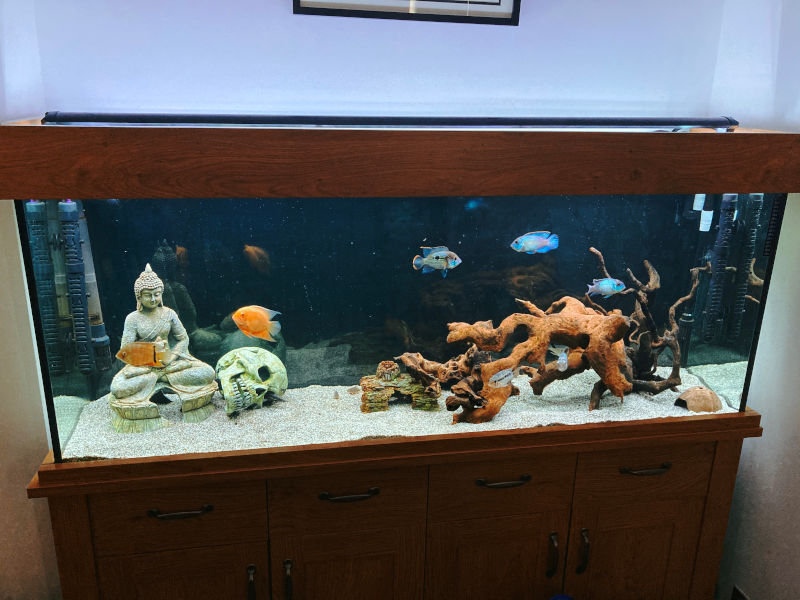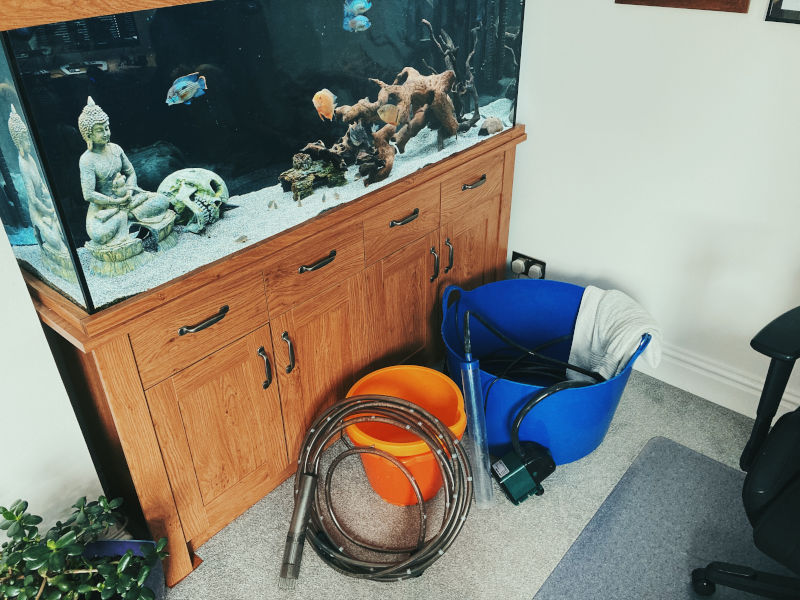Looking After An Aquarium – How Much Work Is Involved?
04 Oct 2020
Fish are such easy pets to look after, right? You just pop them in a tank, feed them once a day and change the water now and then. Easy. This post explores how much work is involved in looking after an aquarium.
I have news for you - if you want to keep fish, it’s a lot of work! But, it’s really rewarding. In our house we have 3 tanks (sometimes 4), which are as follows:
Aquarium #1 - Goldfish
Our first tank is a 200 litre (approx 55 US gal) cube tank that contains 4 fancy goldfish and a panda garra.
200 litres for 4 goldfish sounds like a lot, right? Actually, that’s too small because goldfish are extremely messy fish. We offset this with a massive filter and lots of water changes. More on that later.
 My goldfish aquarium
My goldfish aquarium
Aquarium #2 - the tropical community
Our next aquarium is a 120 litre (approx 30 US gal) tropical community that has all sorts of fish including tetras, corydoras and shrimp. It’s also full of live plants. It’s a beautiful tank.
 My wife’s tropical community tank
My wife’s tropical community tank
Aquarium #3 - the cichlid tank
The third tank we have is a 350 litre (approx 90 US gal) containing a selection of south America cichlids (pronounced sick-lid), a group of 10 corydora sterbai, a bristlenose pleco and an incredible fire eel.
This tank is behind my desk and is by far my favourite tank. I can watch it for hours.
 My cichlid tank
My cichlid tank
Tank #4 is a hospital tank that we need to setup occasionally. This is used for things like quarantine and sick or bullied fish.
Looking after an aquarium
So like I said; you buy some fish, dump them in a tank, feed them some flakes once a day and change the water now and then. Simple, right?
WRONG!
The first thing you need to do is cycle your aquarium so the nitrogen cycle has a chance to complete. This is to ensure you have an ecosystem that can support your fish.
Once that’s done, you need to keep an eye on your nitrate levels (I’d recommend the API Master Test Kit to test your water). Start by doing a 50% water change once a week, then you can increase or decrease that depending on where your nitrate levels are.
As a rough guide, I try to keep my nitrates below 20ppm, with the max being 40ppm. Ammonia and nitrite levels should always be 0ppm.
The amount of nitrate your tank will produce all depends on a combination of your tank size, what livestock you have, and the filtration you have.
My maintenance routine
To give you an idea of how much work it takes for me to look after my aquariums, here’s my maintenance schedule:
Every Sunday - 50% (150 litre) water change on the cichlid tank. Gravel vacuum and glass clean. Approximate time - 1.5 hours.
Every Tuesday - 50% (60 litre) water change on the community tank. Gravel vacuum, glass clean. Approximate time - 1 hour.
Every Wednesday - 50% (100 litre) water change on the goldfish tank. Gravel vacuum, glass clean. Approximate time - 1 hour.
Also every Wednesday - another 50% (150 litre) water change on the cichlid tank. Approximate time - 45 mins.
Every 3rd Sunday - alternate cannister clean on 1 of the 2 cannister filters I have on the cichlid tank. Approximate time - 45 mins.
Every 4th Tuesday - filter clean on the community tank. Approximate time - 30 mins.
Every 6th Wednesday - cannister clean on the goldfish tank. Approximate time - 45 mins.
Note: a cannister clean involves stripping it down, cleaning the impeller, rinsing all the media and cleaning/replacing the sponges. This is a great video on what’s involved in cleaning a cannister filter:
As you can see, looking after an aquarium is a lot of work. This is why many people who get fish without doing their research find that their fish die pretty quickly.
Did you know that the average lifespan of a goldfish is around 20 years. Most people think it's just a few years as so many are mistreated in the aquarium hobby.
So my maintenance schedule for looking after my aquariums takes somewhere in the region of 4.25 and 6.25 hours per week.
Still think looking after an aquarium isn’t a lot of work?
Feeding the fish
Fish, like any other animal, need a varied diet. Some are carnivore, others are omnivores. Then, to make things even more complicated, some prefer to hunt for their food (like my fire eel) and others are nocturnal.
My goldfish eat a combination of goldfish pellets, fruit & vegetables like courgette (zucchini), melon and spinach. They also eat frozen bloodworm and brine shrimp in garlic.
My cichlids eat a selection of krill flakes, various cichlid pellets (I really like the Hikari brand), frozen bloodworm and brine shrimp in garlic.
Plecos are nocturnal and eat a combination of wood (yes, wood!) and algae. So he needs to have algae wafers put into the tank just before I go to bed - right when he’s out feeding. Plecos also like fruit & veg too.
The fire eel likes to hunt his food, and also prefers low light conditions. So he eats a mixture of live bloodworm, live earthworms and even the occasional feeder shrimp as a special treat.
The community tank tends to eat a mixture a tropical fish flakes, frozen bloodworm, brine shrimp in garlic and copepods.
Finally, the corydoras are bottom feeders that pretty much eat anything that hits the bottom of the tank. Having said that, we still target feed them with corydora pellets. Corydoras also love fruit and veg too.
Not quite as simple as buying a pack of cheap flakes, right?
Some recommendations
On small aquariums, doing a water change with buckets is relatively easy. But once you get into the territory of aquariums that are 100+ litres, you really need to ditch the buckets.
I do this by using a submersible pump that pumps the water straight down the toilet, or into the water butt in the garden.
To re-fill the aquariums I use a JBL Aqua In Out, which allows me to attach it to the tap (faucet) via a long hose. This can also be used as a gravel cleaner too, but I don’t find the suction to be very good.
Instead, I use a standard gravel vacuum, which goes into a large 75 litre bucket. I then pump the water out using the submersible pump I mentioned earlier.
By using this method of aquarium maintenance, I can knock hours off my weekly maintenance schedule.
 My aquarium maintenance kit
My aquarium maintenance kit
Conclusion
The whole point of this post was to show that fish aren’t the simple pets you think they are. Looking after them properly takes a lot of research, patients and work.
But in return you get to watch some of the most beautiful organisms in the animal kingdom do their thing. I’ve been keeping fish for around 5 years now, and I can’t see myself ever being without at least 1 fish tank in the house.
If you’re thinking about getting an aquarium, I’d say do it! But please do your research first to make sure you setup the right habitat for the type of fish you want to keep. That includes the right tank mates, food, tank size, water conditions, tank scape (places to hide, plants etc.) and filtration.
/r/aquariums on Reddit is a great place to start if you’re new to fish keeping. Alternatively, you can leave a comment below and I’ll do my best to help.